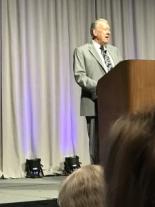SpringBoard is pleased to offer a review of this BCG Skillbuilding lecture, presented 4 May 2018.
F321, Thomas Wright Jones, PhD, CG®, CGL℠, FASG, FNGS, FUGA, “Using Indirect and Negative Evidence to Prove Unrecorded Events”
Reviewed by Jean Andrews, CG®
“Information hidden below the surface or totally absent helps researchers reconstruct events, identities, and relationships which no record specifies.”[1]

Less experienced genealogists sometimes struggle to let go of the idea of a single document out there —one that, if it could only be found, would directly state long-sought answers of identity or kinship. This quest can consume years of fruitless searching.
Those who grow wiser and more experienced realize that evidence is created through a thinking process in which words, images, and context found in the present can bridge us back to unobservable past identities, relationships, and events. This is the core of indirect evidence that Dr. Jones presents in this lecture.
Using context in purpose, research, and reasoning allows us to “see” into the past. We can answer questions about past events using sources created in the past which exist in the present. Often we have to read between the lines and look below the surface. Thinking, analysis, and reasoning help us combine evidence which individually does not answer the question, but together provides an answer.
Through the process of thinking, we can create the evidence to solve many common genealogical problems. Researchers build their own brick walls when they label or categorize evidence prematurely, and close off other possibilities which may include less desirable outcomes.
Negative evidence describes when information is missing from a source where the person could appear, or when the absence of information is useful and helps answer the question. Negative evidence rarely is used on its own, and typically is combined with indirect evidence to support a conclusion.
Some uses of negative evidence include establishing age, status, removal, and to eliminate competing possibilities.
We can’t go back to the past to ask questions of those long gone. Likewise, we cannot bring those people or events to the present so that we can get firsthand knowledge of them. What we can do is use the surviving records, images, and accounts to develop the most likely version of prior events, identities, and relationships. Dr. Jones provides the roadmap for doing so in this lecture.
Note: Dr. Jones’s masterful syllabus is a mini–course in the concepts and principles of evidence including a glossary, two case study examples, and many suggestions of additional resources.
A recording of this lecture may be ordered from Playback Now www.playbackngs.com.
The words Certified Genealogist and letters CG are registered certification marks, and the designations CGL and Certified Genealogical Lecturer are service marks of the Board for Certification of Genealogists®, used under license by board certificants after periodic evaluation.
[1] Thomas W. Jones, “Using Indirect and Negative Evidence to Prove Unrecorded Events,” syllabus, session F321, NGS 2018 Family History Conference, Grand Rapids, Michigan, p. 1.